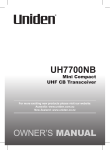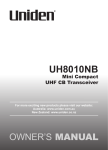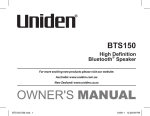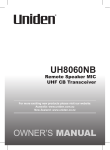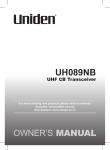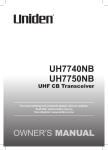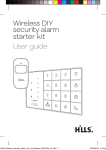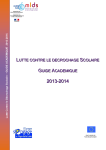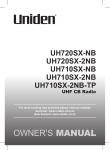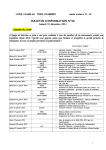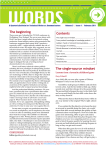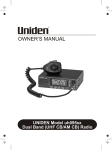Download Uniden UH7700NB Owner`s manual
Transcript
UH7700NB Mini Compact UHF CB Transceiver For more exciting new products please visit our website: Australia: www.uniden.com.au New Zealand: www.uniden.co.nz Contents Introduction3 Controls & Connectors 4 Indicators6 Included with your UH7700NB Transceiver 7 Connecting the Microphone 8 Mounting the MIC Hanger 9 Operation10 Turning on the Power 10 Setting the Squelch Level 10 Monitor 12 Selecting a Channel 12 Programming the Instant Priority Channel 12 Recalling the Instant Channel 13 Transmitting 13 Call Function 13 Using Repeater Channels 13 Operating the UHF CB Radio in Duplex Mode 15 Scanning 15 Open Scan (OS) Mode 16 Group Scan (GS) Mode & Priority Watch 16 Add/Remove Channels from SCAN Memory 17 CTCSS & DCS 17 Busy Channel Lockout 18 Selecting the Call tone 18 Roger Beep 19 Beep On/Off 19 Backlight Colours 19 Backlight Brightness 20 LCD Flip 20 CTCSS Codes Table 21 DCS Codes Table 22 UHF CB Channel Guidelines 23 UHF CB Channels & Frequencies 24 Warranty26 UNIDEN UH7700NB 2 UHF CB Transceiver Introduction The Uniden UH7700NB is designed to provide you with years of trouble free service. Its rugged components and materials are capable of withstanding harsh environments. Please read this Operating Manual carefully to ensure you gain the optimum performance of the unit. NOTE The citizen band radio service is licenced in Australia by ACMA Radio-communications (Citizen Band Radio Stations) Class Licence and in New Zealand by MED General User Licence for Citizen Band Radio and operation is subject to conditions contained in those licenses. Features • 38 built in CTCSS (Continuous Tone Coded Squelch System) codes and 104 DCS (Digital Coded Squelch) are selectable • Auto squelch detection threshold control (“oF”, “1” ~ “9”) • Volume control (“oF”, “1” ~ “40”) • Power On/Off control SW • Optional External Speaker • Flip LCD function • 7 LCD/Key Backlight Colour Options • 4 LCD/Key Backlight Brightness Levels • Under and over voltage alert function • Narrow Band (NB) 80 Channel Radio* • 12V DC Power Input • Built-in AVS Circuitry† • Transmission power 5W • LCD display • Signal strength and RF power (S/RF) meter • Instant channel programming • One touch Instant channel recalling • Selectable scanning type from group scan (GS) and open scan (OS). • Scan channel memory On/Off function separately divided into OS and GS • Monitor On/Off function • Duplex capability* • Key Beep On/Off function • Rotary Channel select knob • Busy Channel lock-out function • Roger beep function On/Off • 5 different CALL Tones UNIDEN UH7700NB * Refer to p.23 - p.25 for channel information † AVS - Automatic Volume Stabilizer detects and manages incoming audio to comparable levels. 3 UHF CB Transceiver Controls & Connectors 1 6 2 5 7 8 4 3 UH7700 NB Series Standard Microphone 9 10 15 CALL 11 13 INST 12 14 16 UNIDEN UH7700NB 4 UHF CB Transceiver Controls & Connectors 1 10 UHF Antenna Connection Menu Button / Monitor function (press & hold) 11 CALL - Call Tone Button 2 PUSH control - Squelch 12 INST - Instant Channel Button Select (press) /Power On/Off (press & hold) ROTARY control - CHANNEL Selector 3 / control 4 13 PTT - Push To Talk Button 14 MICROPHONE - Volume Up/Down 15 RJ45 type plug Channel Scan button / Scan Memory (press & hold) 16 Front MIC Jack Cover 5 Liquid Crystal Display (LCD) 6 MIC - Front Microphone Jack 7 Speaker 8 Power Input Connection (13.8VDC) 9 EXT SP - External Speaker Jack UNIDEN UH7700NB 5 UHF CB Transceiver Indicators 6 5 4 3 2 1 1 - Receive Signal Level (Channel Busy Indicator) - Transmit Signal Power Level 2 - Channel Number / Menu Item Setting 3 - CTCSS/DCS Code number / Menu Item 4 - Scan mode 5 - Channel in Memory 6 - Instant Channel UNIDEN UH7700NB 6 UHF CB Transceiver Included with your UH7700NB Transceiver Bt Nac 77ra00 UHUlt Comp Radio UHF e Mobil our e visit ucts pleas m.au new prod .uniden.co .nz exciting ralia: www .uniden.co Aust For more nd: www New Zeala Standard Microphone website: Owner’s Manual Mounting Bracket with mounting screws Microphone Hanger with screws, washers DC Power Cord with fuse Optional Accessories: • BTMIC kit • UHF Antenna • External Speaker Visit the UH7700NB page on the website for more information on the availability of optional accessories; www.uniden.com.au for Australia www.uniden.co.nz for New Zealand UNIDEN UH7700NB 7 UHF CB Transceiver Connecting the Microphone MIC Jack Push the MIC plug at the end of the microphone into the MIC jack until the connection locks into place. Gently tug the MIC cord to test that the connection is locked. Use the rubber cover which is on the MIC cord to seal the MIC jack entry from dust. Disconnecting the MIC from the MIC Jack Pull back the rubber cover and move it down along the cord. Using the flat blade of a screwdriver or similar object carefully push the lock tab of the MIC plug towards the MIC cord and at the same time tug on the MIC cord to draw back the MIC plug. UNIDEN UH7700NB 8 UHF CB Transceiver Mounting the MIC Hanger The Microphone Hanger comes in two parts. How and where you mount the MIC hanger will determine which parts to use. Conventional Mounting with Screws Use the front part of the MIC Hanger only. Locate a suitable mounting position and mark and drill two 3mm holes. Fix the MIC Hanger into place with screws. Conventional Mounting with Double Sided Tape (not supplied) High quality Double-Sided tape can be found at good retail stores. Secure the front and back pieces of the MIC Hanger using the supplied binding screws. Locate a suitable mounting position. Apply high quality Double-Sided tape onto the flat area of the MIC Hanger back piece and then press firmly to the mounting position. UNIDEN UH7700NB 9 UHF CB Transceiver Operation Turning on the Power Press and hold the Power/Channel Selector. Low-Voltage/High-Voltage Alert If the power supply voltage exceeds 18VDC, an alert tone sounds and dc HI flashes for 5 seconds. The power source must not exceed 25VDC otherwise permanent damage may occur to your radio, which may not be covered by the manufacturer’s warranty. NOTE If the input voltage falls below 10VDC, dc Lo flashes for 5 seconds. The power turns off automatically if voltage falls below 8.5VDC. Switch your UH7700NB OFF and disconnect it from the power source, before locating the cause of the power supply problem. Setting the Squelch Level Press the Power/Channel Selector momentarily. SqL shows and the current squelch level will flash. Turn the Channel Selector to select the desired squelch level. UNIDEN UH7700NB 10 UHF CB Transceiver Operation oF(off) - squelch open. 1 - max sensitivity (min squelch) 5 - med sensitivity (med squelch) 9 - min sensitivity (max/tight squelch) NOTE You must select a channel which is not in use before setting the SQUELCH control. (see p.12 for “Selecting a Channel”). Think of the squelch control as a gate. If you increase the squelch level to maximum it raises the ‘Squelch gate’ so only the strongest signals get through. If you decrease the squelch level to minimum it lowers the ‘Squelch Gate’ to the extent that weak signals can get through. If unwanted weak and noisy signals are getting through increase the squelch level (‘Squelch Gate’) to a medium level. Now only medium and strong signals get through. UNIDEN UH7700NB 11 UHF CB Transceiver Operation Monitor Press and hold to open the squelch and receive all weak signals. Press and hold again to cancel. Selecting a Channel Turn the Channel Selector to select the desired channel. NOTE For your reference a list of the available channels, corresponding frequencies and guidelines for their use and selection is printed on page 23. For Australia, Channels 05 UH7700 Seriesfor Standard Microphone and 35 areNB reserved Emergency Calls. Programming the Instant Priority Channel Turn the Channel Selector to select the Priority Channel you prefer. Press and hold [INST] on the microphone for 2 seconds to store the new setting. The icon appears. CALL UNIDEN UH7700NB 12 INST UHF CB Transceiver Operation Recalling the Instant Channel Momentarily press [INST] on the microphone at any time to return to the Instant Channel. Press [INST] again to return to the previous channel. Transmitting The UHF CB Radio uses UHF-CB Channels. NOTE For your reference a list of the available channels, corresponding frequencies and guidelines for their use and selection is printed on page 23. For Australia, Channels 05 and 35 are reserved for Emergency Calls. Select the desired channel. Press the microphone’s PTT button and speak normally into the microphone. Hold it approx. 7cm from your mouth. Release the [PTT] button to end the transmission and listen for a reply. Call Function Press [CALL] on the microphone. A three second ringing tone will be transmitted. You may select from 5 types of tones (see p.18 for “Selecting the Call tone”). NOTE Current regulations require calling tones to be restricted to one transmission per minute. If a second transmission is attempted within one minute then an error tone will sound. Using Repeater Channels UHF CB Repeaters are used to retransmit or relay your signal. Repeaters will extend the range of your radio and overcome the shielding effect caused by solid obstructions. In normal Simplex operation, your radio transmits on one particular frequency and receives on that same frequency. If there is a barrier that partially blocks your transmitted signal, the probability of another radio receiving the signal is very slim. Hills, tall buildings, metallic structures,...etc tend to act as a screen between radios. UNIDEN UH7700NB 13 UHF CB Transceiver Operation Standard Operation without the aid of a Repeater station. Operation with the aid of a Repeater Repeater Station (Duplex). The signal coming from your radio is received by the Repeater Station and the re-transmitted at the same time on another channel. This operation is called “Duplexing”. For example, CH01 on Duplex Mode will Receive on CH01 but Transmit on CH31 CH02 on Duplex Mode will Receive on CH02 but Transmit on CH32 etc... If you transmit on CH01 Duplex mode, you are actually transmitting on CH31 the repeater station down-converts your signal and retransmits on CH01. UNIDEN UH7700NB 14 UHF CB Transceiver Operation Operating the UHF CB Radio in Duplex Mode For this example we are adopting CH01 as the channel being used in your area for repeater use. 2 times. The duplex setting flashes. 1. Press / to change the setting 2. Turn the Channel Selector or press between simplex and duplex (“ r ” for repeater channels 01 - 08 or “ n “ for repeater channels 41 - 48). 3. Press to store the setting. to save & exit the menu mode. Only channels 4. Press and hold 01 - 08 and 41 - 48 are available for Duplex. NOTE Check with your local Retailer for information on available repeaters. Scanning The scan feature allows you to search for active channels automatically. The UH7700NB has two types of scanning; Open Scanning (OS) and Group Scanning (GS), to give you flexibility and allow you to use the radio more effectively. and Scanning starts. The icon appears. The scan 1.Press direction can be changed at any time by rotating the channel selector left or right. UNIDEN UH7700NB 15 UHF CB Transceiver Operation 2.To deactivate SCAN, press . Open Scan (OS) Mode Allows continuous scanning of all selected channels. If an active channel is found, scanning will stop on that channel. If the received signal ceases, the unit will wait 3 seconds for the signal to return, otherwise scanning resumes. After transmission in scan mode, the unit will wait 20 seconds for the signal to return, otherwise scanning resumes. To skip the active channel, turn the Channel Selector. Group Scan (GS) Mode & Priority Watch Includes the accessory feature, Priority Watch, which allows you to monitor the Instant Priority Channel while scanning. To use GS Mode Scanning; 1. Press 3 times. Scn shows and the oS/GS setting flashes. 2. Turn the Channel Selector or press 3. Press / to change the setting to GS. to store the setting. 4. Press and hold to save & exit the menu mode. GS Scanning checks the Instant Priority Channel for activity every 1.5 seconds. UNIDEN UH7700NB 16 UHF CB Transceiver Operation If the Priority Channel becomes active the radio will stay on that channel for as long as the signal is present. If the received signal ceases, Priority Scanning continues after 3 seconds. If scanning stops on a channel which is not a Priority Channel, the radio will continue monitoring the Priority Channel for activity while listening to the active one. To deactivate SCAN, press the button. Add/Remove Channels from SCAN Memory Select which Scanning Mode you wish to use; OS or GS. Select the channel you want to store. Press and hold to store. The icon appears and a short tone is heard. To remove the channel from SCAN memory, press and hold once more. The icon disappears. CTCSS (Continuous Tone Coded Squelch System) & DCS (Digital Coded Squelch) Turn the Rotary Channel Selector to the desired channel to use CTCSS or DCS. 1. Press 1 time. CTCSS/DCS setting appears. 2.Turn the Channel Selector or press / to select the desired CTCSS code 01 - 38 or DCS code 01 - 104 (code 100 - 104 is represented by o0 - o4). To turn off CTCSS/DCS select the oF code. 3. Press to store the setting. to save & exit menu mode. 4. Press & hold The CTCSS/DCS code displays for the selected channel. UNIDEN UH7700NB 17 UHF CB Transceiver Operation Busy Channel Lockout If the channel is already in use, you can prevent the UHF CB Radio from transmitting . This is particularly important when using CTCSS/DCS. 1. Press 4 times. The BCL setting flashes. 2. Turn the Channel Selector or press between ON or OFF. 3. Press / to change the setting to store the setting. 4. Press and hold to save & exit menu mode. Selecting the Call tone 1. Press 5 times. The call tone setting flashes. 2. Turn the Channel Selector or press between 1, 2, 3, 4 and 5. 3. Press / to change the setting to store the setting. 4. Press and hold UNIDEN UH7700NB to exit from the menu mode. 18 UHF CB Transceiver Operation Roger Beep 1. Press 6 times. The roger beep setting flashes. 2. Turn the Channel Selector or press between ON or OFF. 3. Press / to change the setting to store the setting. 4. Press and hold to save & exit menu mode. Beep On/Off 1. Press 7 times. The Beep setting flashes. 2. Turn the Channel Selector or press between ON or OFF. 3. Press / to change the setting to store the setting. 4. Press and hold to save & exit menu mode. Backlight Colours 1. Press 8 times. The Backlight setting flashes. / to change the setting 2. Turn the Channel Selector or press between Blue, Red, Purple(magenta), Green, Cyan, Yellow and Clear (white). 3. Press to store the setting. 4. Press and hold UNIDEN UH7700NB to exit from the menu mode. 19 UHF CB Transceiver Operation Backlight Brightness 1. Press 9 times. The Backlight Brightness setting flashes. 2. Turn the Channel Selector or press / between Off (oF), 1(Lo), 2(mid) and 3(Hi). 3. Press to change the setting to store the setting. 4. Press and hold to save & exit menu mode. LCD Flip 1. Press 10 times. The Flip setting flashes. 2. Turn the Channel Selector or press orientation. 3. Press / to change the flip to store the setting. 4. Press and hold UNIDEN UH7700NB to save & exit menu mode. 20 UHF CB Transceiver CTCSS codes table Code No. Frequency (Hz) Code No. Frequency (Hz) “oF’ OFF 20 131.8 1 67.0 21 136.5 2 71.9 22 141.3 3 74.4 23 146.2 4 77.0 24 151.4 5 79.7 25 156.7 6 82.5 26 162.2 7 85.4 27 167.9 8 88.5 28 173.8 9 91.5 29 179.9 10 94.8 30 186.2 11 97.4 31 192.8 12 100.0 32 203.5 13 103.5 33 210.7 14 107.2 34 218.1 15 110.9 35 225.7 16 114.8 36 223.6 17 118.8 37 241.8 18 123.0 38 250.3 19 127.3 UNIDEN UH7700NB 21 UHF CB Transceiver DCS codes table Code No. 1 2 3 4 5 6 7 8 9 10 11 12 13 14 15 16 17 18 19 20 21 22 23 24 25 26 27 28 29 30 31 32 33 34 35 DCS Code (Octal) 023 025 026 031 032 036 043 047 051 053 054 065 071 072 073 074 114 115 116 122 125 131 132 134 143 145 152 155 156 162 165 172 174 205 212 UNIDEN UH7700NB DCS Code (Octal) 223 225 226 243 244 245 246 251 252 255 261 263 265 266 271 274 306 311 315 325 331 332 343 346 351 356 364 365 371 411 412 413 423 431 432 Code No. 36 37 38 39 40 41 42 43 44 45 46 47 48 49 50 51 52 53 54 55 56 57 58 59 60 61 62 63 64 65 66 67 68 69 70 22 Code No. 71 72 73 74 75 76 77 78 79 80 81 82 83 84 85 86 87 88 89 90 91 92 93 94 95 96 97 98 99 100 (do0) 101 (do1) 102 (do2) 103 (do3) 104 (do4) DCS Code (Octal) 445 446 452 454 455 462 464 465 466 503 506 516 523 526 532 546 565 606 612 624 627 631 632 654 662 664 703 712 723 731 732 734 743 754 UHF CB Transceiver UHF CB Channel Guidelines NOTE Always listen on a channel (or observe the receive signal level meter) to ensure it is not already being used before transmitting. Channels 5 and 35 are used for emergency channels. CTCSS and DCS will not operate on these channels. Please follow these guidelines for channel use in Australia: • Channels 05 and 35 are Emergency Channels. • Channel 11 is a Calling Channel. • Channels 22 and 23 are for telemetry and telecommand applications, channels 61, 62 and 63 are for future use and TX is inhibited on these channels. General communication is accepted on all other channels with these guidelines: • Channel 40 - road channel (Australia). • Channels 01-08 (and 31-38), and Channels 41-48 (and 71-78) are repeater channels. Important information - 80 Channel UHF CB channel expansion To provide all users additional channel capacity within the UHF CB Band. The ACMA will change the majority of the current wideband 40 channel use to narrowband channel use. This allows for additional channels to be added, up to 80 Channels. This simply means that the new narrowband radio you have purchased will have more channels than older radios. Please refer to the guidelines above and the channel chart for further channel information. A list of currently authorised channels can also be obtained from the ACMA website in Australia and the MED website in New Zealand. NOTE Interference / Poor Audio When a new narrowband radio receives a signal from an older wideband radio the speech may sound loud - however the UH7700NB’s built-in AVS (Automatic Volume Stabilizer) circuitry will detect and manage incoming audio to comparable levels. Narrowband radios operating on CH41 - CH80 may encounter interference from a nearby wideband radios transmitting on high power on an adjacent channel (frequency). When an older wideband radio receives a signal from a new narrowband radio the speech may sound quiet - the wideband radio user simply adjusts their radio volume for best performance. The above situations are not a fault of the radio but a symptom of mixed wideband and narrowband radios in current use. It is expected that as older wideband radios are phased out this issue will be eliminated. UNIDEN UH7700NB 23 UHF CB Transceiver UHF CB Channels & Frequencies CH No. Simplex Mode Transmit / Receive Frequency (MHz) Duplex Mode Transmit Frequency (MHz) CH No. Simplex Mode Transmit / Receive Frequency (MHz) 1 476.425 477.175 (CH31) 21 476.925 2 476.450 477.200 (CH32) 22 476.950 (RX only) 3 476.475 477.225 (CH33) 23 476.975 (RX only) 4 476.500 477.250 (CH34) 24 477.000 5 476.525 477.275 (CH35) 25 477.025 6 476.550 477.300 (CH36) 26 477.050 7 476.575 477.325 (CH37) 27 477.075 8 476.600 477.350 (CH38) 28 477.100 9 476.625 29 477.125 10 476.650 30 477.150 11 476.675 31 477.175 12 476.700 32 477.200 13 476.725 33 477.225 14 476.750 34 477.250 15 476.775 35 477.275 16 476.800 36 477.300 17 476.825 37 477.325 18 476.850 38 477.350 19 476.875 39 477.375 20 476.900 40 477.400 UNIDEN UH7700NB 24 UHF CB Transceiver UHF CB Channels & Frequencies CH No. Simplex Mode Transmit / Receive Frequency (MHz) Duplex Mode Transmit Frequency (MHz) CH No. Simplex Mode Transmit / Receive Frequency (MHz) 41 476.4375 477.1875 (CH 71) 61 42 476.4625 477.2125 (CH 72) 62 43 476.4875 477.2375 (CH 73) 63 future use 476.9375 (RX only) future use 476.9625 (RX only) future use 476.9625 (RX only) 44 476.5125 477.2625 (CH 74) 64 477.0125 45 476.5375 477.2875 (CH 75) 65 477.0375 46 476.5625 477.3125 (CH 76) 66 477.0625 47 476.5875 477.3375 (CH 77) 67 477.0875 48 476.6125 477.3625 (CH 78) 68 477.1125 49 476.6375 69 477.1375 50 476.6625 70 477.1625 51 476.6875 71 477.1875 52 476.7125 72 477.2125 53 476.7375 73 477.2375 54 476.7625 74 477.2625 55 476.7875 75 477.2875 56 476.8125 76 477.3125 57 476.8375 77 477.3375 58 476.8625 78 477.3625 59 476.8875 79 477.3875 60 476.9125 80 477.4125 UNIDEN UH7700NB 25 UHF CB Transceiver Warranty UNIDEN UH7700NB UHF CB Transceiver IMPORTANT: Satisfactory evidence of the original purchase is required for warranty service Please refer to our Uniden website for any details or warranty durations offered in addition to those contained below. Warrantor: The warrantor is either Uniden Australia Pty Limited ABN 58 001 865 498 (“Uniden Aust”) or Uniden New Zealand Limited (“Uniden NZ”) as the case may be. Terms of Warranty: Uniden Aust/NZ warrants to the original retail purchaser only that the UH7700NB (“the Product”), will be free from defects in materials and craftsmanship for the duration of the warranty period, subject to the limitations and exclusions set out below. Warranty period: This warranty to the original retail purchaser is only valid in the original country of purchase for a Product first purchased either in Australia or New Zealand and will expire three (3) years from the date of the original retail sale. If a warranty claim is made, this warranty will not apply if the Product is found by Uniden to be: (A) Damaged or not maintained in a reasonable manner or as recommended in the relevant Uniden Owner’s Manual; (B) Modified, altered or used as part of any conversion kits, subassemblies or any configurations not sold by Uniden Aust or Uniden NZ; (C) Improperly installed contrary to instructions contained in the relevant Owner’s Manual (D) Repaired by someone other than an authorized Uniden Repair Agent in relation to a defect or malfunction covered by this warranty; or (E) Used in conjunction with any equipment, parts or a system not manufactured by Uniden. Parts Covered: This warranty covers the Product and included accessories. User-generated Data: This warranty does not cover any claimed loss of or damage to user-generated data (including but without limitation phone numbers, addresses and images) that may be stored on your Product. UNIDEN UH7700NB 26 UHF CB Transceiver Warranty Statement of Remedy: If the Product is found not to conform to this warranty as stated above, the Warrantor, at its discretion, will either repair the defect or replace the Product without any charge for parts or service. This warranty does not include any reimbursement or payment of any consequential damages claimed to arise from a Product’s failure to comply with the warranty. Our goods come with guarantees that cannot be excluded under the Australian Consumer Law. You are entitled to a replacement or refund for a major failure and for compensation for any other reasonably foreseeable loss or damage. You are also entitled to have the goods repaired or replaced if the goods fail to be of acceptable quality and the failure does not amount to a major failure. This warranty is in addition to and sits alongside your rights under either the COMPETITION AND CONSUMER ACT 2010 (Australia) or the CONSUMER GUARANTEES ACT (New Zealand) as the case may be, none of which can be excluded. Procedure for obtaining warranty service: Depending on the country in which the Product was first purchased, if you believe that your Product does not conform with this warranty, you should deliver the Product, together with satisfactory evidence of your original purchase (such as a legible copy of the sales docket) to Uniden at the addresses shown below. You should contact Uniden regarding any compensation that may be payable for your expenses incurred in making a warranty claim. Prior to delivery, we recommend that you make a backup copy of any phone numbers, images or other data stored on your Product, in case it is lost or damaged during warranty service. UNIDEN AUSTRALIA PTY LTD Service Division 345 Princes Highway, Rockdale, NSW 2216 Phone: 1300 366 895 Email: [email protected] UNIDEN UH7700NB UNIDEN NEW ZEALAND LTD Service Division 150 Harris Road, East Tamaki Auckland 2013 Phone: (09) 273 8377 Email: [email protected] 27 UHF CB Transceiver THANK YOU FOR BUYING A UNIDEN PRODUCT. © 2011 Uniden Australia Pty Limited. Uniden New Zealand Ltd. Printed in PRC. UTZZ01945ZB(0) Start Here! BTMIC KIT Charge the Remote PTT How is the BTMIC Kit used? Remote PTT using Wired Earpiece MIC 1.Plug the AC Adaptor cord, or the Car Charger cord into the headset/charge jack of the Remote PTT. Remote PTT using Optional Bluetooth Headset1 Bluetooth Microphone (BM100) Quick Start Guide | Owner’s Manual Thank you for purchasing this Uniden product. The BTMIC Kit provides freedom from the constraints of the corded microphone of your compatible UHF CB Mobile Radio. Use the Remote PTT with the included earpiece MIC or with an optional Bluetooth Headset/Car Kit¹. The BTMIC Kit is compatible with the following UHF CB Mobile Radios; UH7700NB UH7740NB UH7750NB Check the Package Contents Make sure your Bluetooth Microphone’s packaging includes the following items. 2.Plug the AC adaptor to a 240V AC power outlet, or the Car Charger to a +12 to +24VDC cigar socket. The LED indicator is red when charge power is present. For the initial charging, charge the Remote PTT for 14hrs before use. Use only the Uniden AC adaptor supplied. PTT (Push To Talk) Connect the Bluetooth MIC to the UHF CB Mobile Radio 1.Unplug the Standard MIC from the BTMIC Kit compatible mobile radio (UH7700NB, UH7740NB or UH7750NB). Bluetooth MIC (BM100) Remote PTT 2.Plug in the Bluetooth MIC and fit the rubber dust cover. PTT (Push To Talk) The Bluetooth MIC (BM100) is specified to Bluetooth version 2.1 with HSP profile and may pair to a compatible optional Bluetooth Headset/Car Kit with HSP profile. Compatibility and full operation is not guaranteed. 1 Parts of the BTMIC KIT Remote PTT Bluetooth MIC (BM100) CALL INSTANT Volume Up/Down AC Adaptor +12 to +24VDC Car Charger Connect the Wired Earpiece MIC to the Remote PTT PTT Bluetooth LED indicator Power On/Off 1.Connect the wired earpiece MIC to the wired earpiece MIC/charge jack of the Remote PTT. Wired Earpiece MIC Microphone Hanger, Screws & Washers If any of these items are damaged or missing contact your place of purchase! Use only the Uniden wired Earpiece MIC which comes in the package. Do not connect the Earpiece MIC if intending to use an optional Bluetooth Headset/Car Kit (see “How is the BTMIC Kit used?”). LINK (Bluetooth on/off button) LED Indicator Wired Earpiece MIC/ Charge Jack TALK (PTT) Basic Operation Pairing the Blueetooth MIC with an Optional Bluetooth Headset/Car Kit2 Using the Bluetooth MIC as a Standard MIC 1.Press & hold for 4 seconds the Bluetooth MIC’s LINK button to start pairing mode. Put the optional Bluetooth Headset into pairing mode (see instructions for the Bluetooth Headset/Car Kit). The Bluetooth MIC and the Bluetooth Headset/ Car Kit will pair automatically*. At any time the Bluetooth MIC can be used just like the Standard MIC for PTT, CALL and INSTANT function. When using PTT on the Bluetooth MIC the Bluetooth MIC’s microphone is used. Power On/Off Bluetooth MIC 1.Bluetooth MIC automatically turns on when the mobile radio powers on. 2.When the mobile radio has power: Press LINK for 2 seconds to directly turn the Bluetooth feature On or Off. The LED flashes Blue 3 times when the Bluetooth feature turns on. The LED flashes Blue & Red when the Bluetooth feature turns off. Remote PTT *The PIN code for pairing is “0000”, this is exchanged automatically. ²Only one Bluetooth Headset/Car Kit can be paired with the Bluetooth MIC. Compatibility and full operation is not guranteed. To Delete Pairing Information To Reset the Bluetooth MIC: 1.Press & hold for 4 seconds the Bluetooth MIC’s LINK button while powering On the UHF CB Mobile Radio. To Reset the Remote PTT: 1.First power Off the Remote PTT. 2.Press & hold for 4 seconds TALK and Power. Using the Remote PTT to Transmit 1.Press TALK on the Remote PTT to activate the Bluetooth MIC’s PTT output. • Pressing the optional Bluetooth Headset/Car Kit’s Talk/connect button controls the audio connection. • During a transmission using the Remote PTT wired Headset or Bluetooth Headset/Car Kit, PTT output is stopped when either device moves out of range of the Bluetooth MIC. • If the Bluetooth Headset/Car Kit is also paired to a mobile phone, and a transmission is in progress when an incoming call is received, the transmission is stopped and the Bluetooth Headset/Car Kit switches to the mobile phone call3. • When the Bluetooth Headset/Car Kit ends a mobile phone call, the audio connection will be restarted either by pressing TALK on the Remote PTT or by receiving a transmission. If the optional Bluetooth Headset/Car Kit is multipoint capable, you may switch to a mobile phone call. This function depends on the specification of your Bluetooth Headset/Car Kit. Compatibility and full operation is not guaranteed. 3 LED and Tone Indicators Specifications Bluetooth SPEC : VERSION 2.1/Class 2 Bluetooth Profile : HSP (Headset Profile) Limited One Year Warranty Bluetooth Microphone BTMIC Kit IMPORTANT: Satisfactory evidence of the original purchase is required for warranty service Please refer to our Uniden website for any details or warranty durations offered in addition to those contained below. Warrantor: The warrantor is either Uniden Australia Pty Limited ABN 58 001 865 498 (“Uniden Aust”) or Uniden New Zealand Limited (“Uniden NZ”) as the case may be. Terms of Warranty: Uniden Aust/NZ warrants to the original retail purchaser only that the BTMIC Kit (“the Product”), will be free from defects in materials and craftsmanship for the duration of the warranty period, subject to the limitations and exclusions set out below. Warranty period: This warranty to the original retail purchaser is only valid in the original country of purchase for a Product first purchased either in Australia or New Zealand and will expire one (1) year from the date of the original retail sale. If a warranty claim is made, this warranty will not apply if the Product is found by Uniden to be: (A) Damaged or not maintained in a reasonable manner or as recommended in the relevant Uniden Owner’s Manual; (B) Modified, altered or used as part of any conversion kits, subassemblies or any configurations not sold by Uniden Aust or Uniden NZ; (C) Improperly installed contrary to instructions contained in the relevant Owner’s Manual (D) Repaired by someone other than an authorized Uniden Repair Agent in relation to a defect or malfunction covered by this warranty; or (E) Used in conjunction with any equipment, parts or a system not manufactured by Uniden. Bluetooth MIC LED Indication Parts Covered: This warranty covers the Product and included accessories. Powering On Blue LED blinks 3 times Power On (Remote PTT/Blueooth headset not connected) Blue LED blinks 1 time every 5 seconds User-generated Data: This warranty does not cover any claimed loss of or damage to user-generated data (including but without limitation phone numbers, addresses and images) that may be stored on your Product. Powering Off (via LINK button) Blue & Red LED blinks for 2 seconds Power Off (Mobile Radio) LED turns off Connected to Remote PTT with Wired Earpiece MIC Blue LED blinks 2 times every 5 seconds Connected to Remote PTT without Wired Earpiece MIC Blue LED blinks 3 times every 5 seconds Connected to Remote PTT & Bluetooth Headset/Car Kit Blue LED blinks 4 times every 5 seconds Pairing Blue LED and Red LED will blink alternately Remote PTT LED Indication Pairing the Bluetooth MIC with the Remote PTT Powering On Blue LED blinks 3 times Power On (Remote PTT/Blueooth headset not connected) Blue LED blinks 1 time every 5 seconds Connected to Bluetooth MIC with Wired Earpiece MIC Blue LED blinks 2 times every 5 seconds The Bluetooth MIC and Remote PTT come already paired for your convenience. If you need to pair the Remote PTT to the Bluetooth MIC first do “Delete Pairing Information”, then; Connected to Bluetooth MIC without Wired Earpiece MIC Blue LED blinks 3 times every 5 seconds Pairing Blue LED and Red LED blink alternately Battery low Red LED blinks 1 time every 5 seconds Battery very low Red LED blinks 2 times every 5 seconds Charging Red LED turns on Tone Indication Tone heard through Headset Power On A 3 tome melody sounds Power Off A low beep sounds Connected to Bluetooth MIC A high beep sounds Disconnected from Bluetooth MIC A low beep sounds Battery low A high beep sounds 1 time every 5 seconds Battery very low A high beep sounds 2 times every 5 seconds 1.Press for 2 seconds to power on. The LED flashes Blue 3 times when turned on (connected headset will hear the turn on melody). The LED flashes Blue & Red when turned off (connected headset will hear a low beep tone). Pairing 1. First power off both the Bluetooth MIC (LINK button) and the Remote PTT. 2.Press & hold for 4 seconds both the Remote PTT’s power key and the Bluetooth MIC’s LINK button to start pairing mode. The Bluetooth MIC and the Remote PTT will pair automatically, with no need to enter a PIN code. Statement of Remedy: If the Product is found not to conform to this warranty as stated above, the Warrantor, at its discretion, will either repair the defect or replace the Product without any charge for parts or service. This warranty does not include any reimbursement or payment of any consequential damages claimed to arise from a Product’s failure to comply with the warranty. Our goods come with guarantees that cannot be excluded under the Australian Consumer Law. You are entitled to a replacement or refund for a major failure and for compensation for any other reasonably foreseeable loss or damage. You are also entitled to have the goods repaired or replaced if the goods fail to be of acceptable quality and the failure does not amount to a major failure. This warranty is in addition to and sits alongside your rights under either the COMPETITION AND CONSUMER ACT 2010 (Australia) or the CONSUMER GUARANTEES ACT (New Zealand) as the case may be, none of which can be excluded. Procedure for obtaining warranty service: Depending on the country in which the Product was first purchased, if you believe that your Product does not conform with this warranty, you should deliver the Product, together with satisfactory evidence of your original purchase (such as a legible copy of the sales docket) to Uniden at the addresses shown below. You should contact Uniden regarding any compensation that may be payable for your expenses incurred in making a warranty claim. Prior to delivery, we recommend that you make a backup copy of any phone numbers, images or other data stored on your Product, in case it is lost or damaged during warranty service. UNIDEN AUSTRALIA PTY LTD Service Division 345 Princes Highway, Rockdale, NSW 2216 Phone: 1300 366 895 Email: [email protected] UNIDEN NEW ZEALAND LTD Service Division 150 Harris Road, East Tamaki Auckland 2013 Phone: (09) 273 8377 Email: [email protected] Thank you for buying a Uniden product © 2011 Uniden Australia Pty Ltd. Uniden New Zealand Ltd. Printed in PRC. UUZZ01369ZA(0)






























